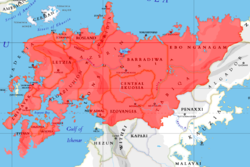Ekuosia
Ekuosia | |
|---|---|
 | |
 | |
| Countries and Territories | Central Ekuosia Template:Country data Orzunia Utol |
| Largest city | Terydnunekuos |
| Largest metropolitan area | Lake Khuda combined statistical area Population: ~30 million |
| Population | |
| • Total | 850,000,000 |
| Demonym(s) | Ekuosian |
Not to be confused with the Barradiwan state-region of Ekuostia.
Ekuosia is a region of Northern Baredina traditionally stretching from the Taanttu and Armizziya seas to Tabiqa and Ebo Nganagam. The region is named after the massive Ekuos River, which is the longest river on Sahar and one of the earliest inhabited by advanced civilizations. With a population of more than 850 million people, Ekuosia is the most populous region on Sahar.
Etymology
The region is named after the Ekuos River, the longest river on Sahar, which passes through a large number of the region's constituent nations. The river has had a massive impact on the history of the region overall.
History
Prehistory
Ekuosia is believed to be host to the area most archaeologists and paleontologists agree was the most likely point of speciation for Homo sapiens roughly 200,000 years ago. The specific area encompasses a relatively small zone around the large lakes shared by Barradiwa, Tabiqa, and Ebo Nganagam. From this point, behaviorally modern humans gradually migrated in all directions, eventually spreading to Miraria, Alpa, Nagu, and lastly Boroso, with human migration to Ystel and Shekku occurring far more recently due to these continents' isolation from Baredina and Miraria, respectively. These migrations spanned several tens of thousands of years, and are generally believed to have occurred in waves separated in time by thousands of years.
As a result of Ekuosia's proximity to humanity's point of speciation, it is home to a wide variety of cultures and languages, with the most variance being present in Ebo Nganagam. The cultural diversity was even greater than it is today the further you look back in time, with the earliest records of the region 5,000 years ago noting several hundred distinct tribes and cultures in the region of Halaria alone. A handful of these cultures survive to the modern day, many of which grew in size to encompass the majority of the region's population.
First Civilizations
On top of being where humanity likely first evolved, Ekuosia is also home to one of the earliest civilizations in recorded history: Ancient Halaria, which was located in a small region of what is now eastern Azerin. This civilization invented writing independently of the Enkeans (in what is now Laefevia) among numerous other technological advances, and the civilization's proximity to the longest river on the planet provided a perfect vessel for the gradual spread of ideas and technology that would facilitate the growth of other early civilizations on Sahar, and especially Baredina.
Little is known of the exact cause of the fall of Halaria, but the general consensus is that some sort of takeover (whether hostile or gradual) by the Letsic people displaced the ancient Halarians and led to a decline of local realms, resulting in the Letsic migrations and the rise of tribal confederations on the outskirts of the many city states holding the region together. The majority of the 3rd millennium BCE was characterized by frequent back-and-forth between agrarian tribal societies and urban city-states controlled by merchants and traders.
Later on in the 3rd millennium BCE, settlements such as Palace City grew large enough to eventually compete with other city-states found along the Ekuos-Khuda confluence. Historians studying this era of history frequently refer to the area around Stalo as "North Halaria" and the area around Palace City as "South Halaria" due to the similarities in the languages people in both areas spoke. The gradual increase in literacy rates and rise of ancient literature led to a boom in regional mythological tales in greater frequency than before, with numerous systems of law and religious beliefs that were previously only passed on via oral tradition being codified and shared with the scholarly caste of each region.
Classical Era
Most of the 2nd millennium BCE was characterized by more migrations and tribal conflicts, although the rise of dynastic rule and the advent of currency led to a gradual boom in regional stability. This millennium also saw the rise of other ancient civilizations, such as the Adzamic and Lonish societies, before being capped off by the monolithic rise of Iovism in Halaria as a standard for which other Halarian belief systems would adapt to. The rise of the Halarian continuum led to the rise of more significant city-states, many of which were built for religious purposes rather than economic or defense. One example of this is Madrana, which even grew to be almost as significant as Stalo at the time due to its status as being where the Council of Madrana would meet.
The Iovist faith spread very slowly at first, initially only catching on in North Halaria before it grew to be a vessel for rapid economic and political development in both North and South Halaria by 500 BCE. The latter half of the 1st millennium BCE was characterized by the rise of numerous classical kingdoms, namely in Western Ekuosia and especially within the Letsatian Basin and the Tabiq-Ekuos confluence. The tail end of the millennium saw the rise of the Letsatian and Adzamasi Empires, which would go on to adversely affect the region's history from both west and east over the following centuries.